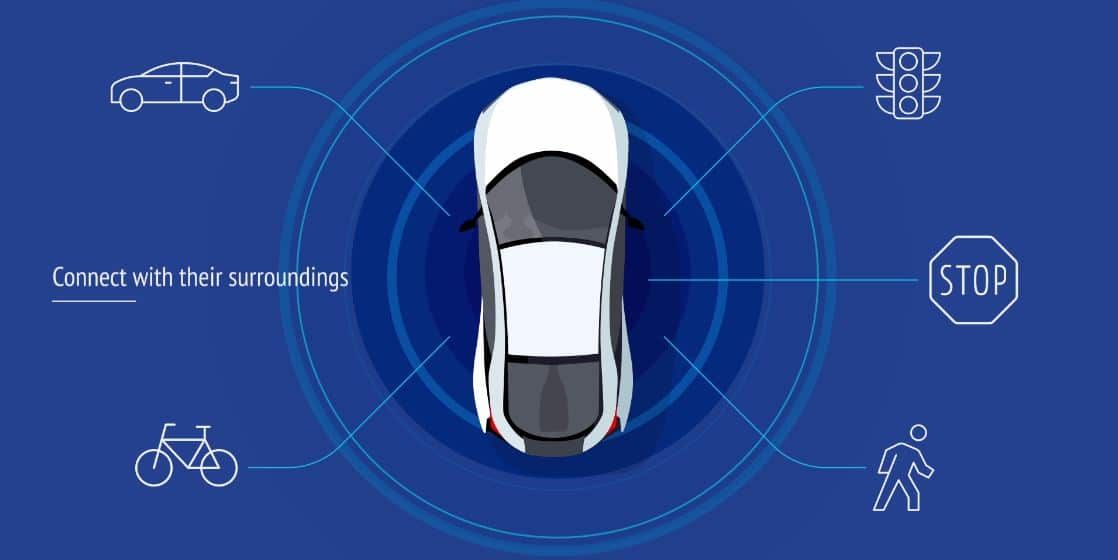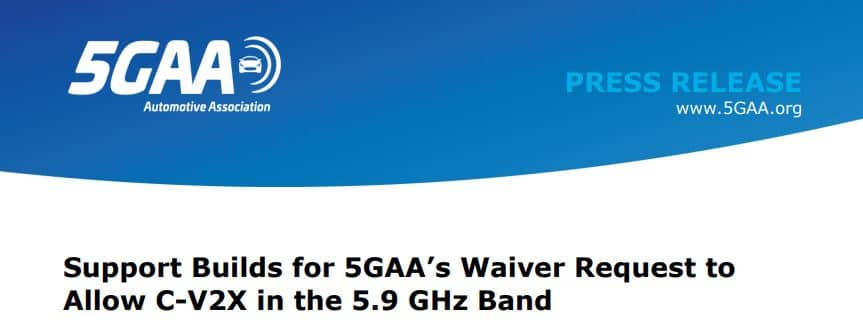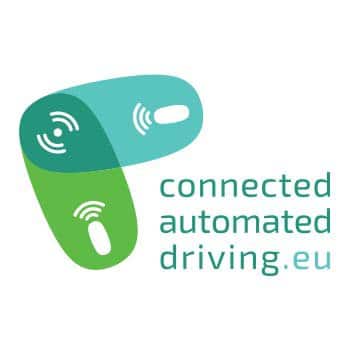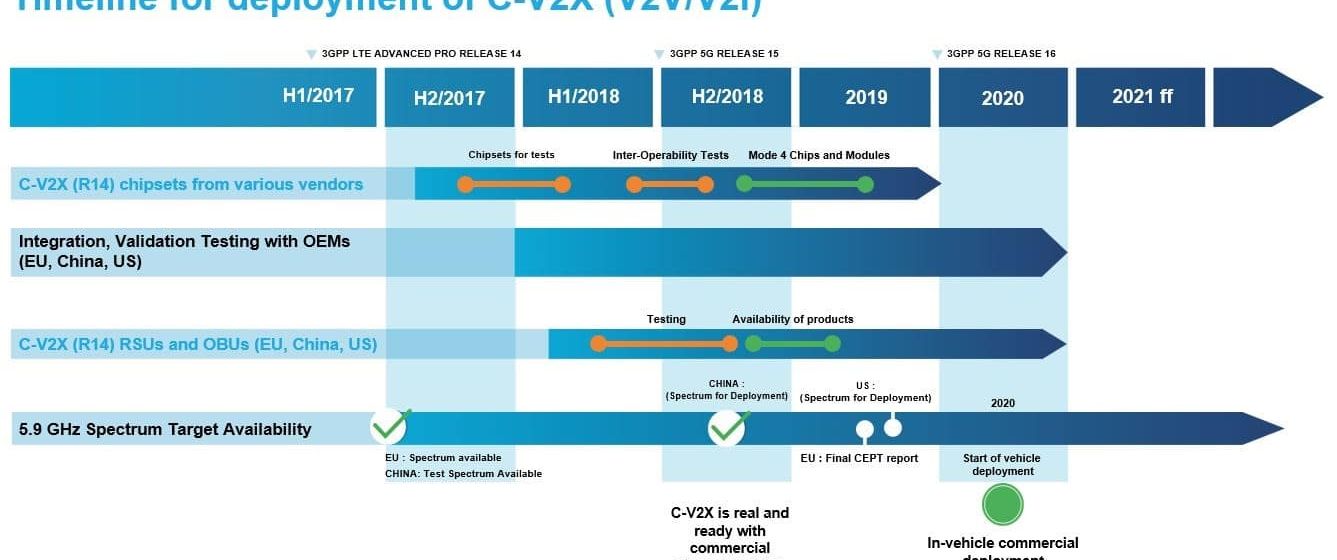
Automotive C-V2X ready to roll out globally, says 5GAA at this year’s MWC Barcelona
All presentations of the 5GAA session at MWC19 Barcelona are available down this page.
February 27th, Barcelona – During today’s well attended keynote, ‘Connecting the Mobility World with 5G’, the 5G Automotive Association (5GAA) gathered experts from the automotive, technology and telecom industries to explain how the deployment of ‘Cellular Vehicle-to-Everything’ (C-V2X) communication technology on the path to 5G is shaping the mobility of the future. Today LTE-V2X, the initial version of C-V2X, stands on the verge of its commercial launch: allowing vehicles to communicate with each other and their surroundings and, together with 5G enhancements, facilitating broad scale improvements in road safety.
“By bringing together key actors of the mobility ecosystem – across the automotive, information and communications technology industries – 5GAA continuously strives to develop forward-looking solutions for intelligent transportation services. Both for today and tomorrow.” stressed Thierry Klein, 5GAA Vice Chair and Head of the Disruptive Innovation Program at Nokia Bell Labs. “These end-to-end integrated solutions bring enhanced safety, sustainability, and convenience to all road users. 5GAA is very excited to be pioneering the revolution towards a smarter and more connected mobility world,” Thierry Klein added.
C-V2X communication is the state-of-the-art, high-speed cellular communications platform that enables vehicles to communicate with one another, with roadside infrastructure, with other road users (such as pedestrians, cyclists, and motorcyclists) using either direct short-range communications or cellular networks. While C-V2X network-based solutions are already widely deployed, direct communication solutions will be commercially available as of this year. As such the C-V2X platform delivers safety, mobility, traffic efficiency, and environmental benefits. C-V2X is designed with an evolutionary path to 5G and supports safe and efficient operations of autonomous vehicles.
5GAA members spearheading C-V2X
A number of 5GAA members are announcing ground breaking use cases at this year’ MWC. 5GAA members Telefónica, Ericsson, Ficosa and Seat show 5G connected car use cases supported by C-V2X direct communication for safer driving in a city (e.g. detection of cyclists when turning right or of a pedestrian at a zebra crossing). Another key technology bringing these use cases to life is edge computing.
In addition, 5GAA members Continental and Vodafone are working together to increase road safety and protect all road users for instance via “digital safety-shield” for cyclists and pedestrians, using C-V2X direct communication and edge computing in the first 5G deployments. The 5G-ready tests are taking place under real-life conditions at Vodafone’s 5G Mobility Lab in Aldenhoven, Germany.
Rohde & Schwarz has announced a collaboration with automotive electronics specialist Vector on a C-V2X end-to-end application layer test solution to verify safety-critical V2X scenarios. The companies’ integrated test platform is showcased for the first time at Mobile World Congress.
Deutsche Telekom has announced first C-V2X tests together with Skoda Auto in Czech as part of the European C-Roads project.
Geely also announced its plans to launch the first mass-produced C-V2X enabled vehicles in China together with Qualcomm in 2021.
Qualcomm has also announced its first 5G automotive platform, enabling both C-V2X short and long-range modes, which is expected to sample later this year and are planned for production vehicles in 2021.
C-V2X direct communication goes commercial in 2019
Mass production of C-V2X chips including direct communication from several suppliers is ongoing, and multiple radio vendors have already integrated these chips into their automotive radio offerings. 2019 is the year when C-V2X direct communication technology will be commercially available across the globe. Furthermore, full interoperability testing on C-V2X applications is ongoing among 5GAA members. The first mass-deployment in vehicles on the roads is anticipated to start in China in 2020; to be followed swiftly in other regions when local regulations allow for it.
“C-V2X is now ready to roll. At Ford, we will begin to deploy this technology in all new models launching in the US starting in 2022” confirmed Don Butler, Executive Director of Connected Vehicle & Services at Ford Motor Co.
The next milestone: 5G New Radio
C-V2X provides a clear evolution path to the family of 5G technologies for both direct and network communication. Part of this evolution is the 5G New Radio (NR).
NR-V2X will eventually ensure safe operation of autonomous driving vehicles by using 5G New Radio with Ultra Reliable Low Latency Communications (URLLC) network based communication combined with improved direct short range communications.
“The development of the NR-V2X standard is due for completion by the end of 2019; eventually hitting the road in 2023. This will enable a new generation of use cases for connected automated vehicles”, said Maxime Flament, CTO at 5GAA.
About 5GAA
The 5G Automotive Association (5GAA) is a global, cross-industry organisation with 110 members working together to develop end-to-end solutions for future mobility and transportation services. The organisation is committed to helping define and develop the next generation of connected mobility for advanced driving and automated vehicle solutions.
Presentations
- Opening speech by Thierry Klein, 5GAA Vice Chair & Nokia Bell Labs / Connecting the Mobility World with 5G-V2X
- Keynote by Friedhelm Ramme, Ericsson / 5G: From Concepts to Reality
- Keynote by Thorsten Hehn, Audi / 5G for Automotive: Key Applications
- Keynote by Jiang Wangsheng, Huawei / C-V2X Enables Intelligent Transportation
- Keynote by Nakul Duggal, Qualcomm / C-V2X Ignites Automotive Connected Revolution
- Speech by Vishnu Sudaram, Harman (Samsung) / Go-To-Market Timeline

5GAA releases White Paper on C-V2X Conclusions based on Evaluation of Available Architectural Options
During the last decade, a set of connected transportation services has been identified utilizing mobile network communication. One question that needs an answer is whether these transportation services can be handled by the current cellular networks or particular enhancements are needed in order to provide a commercially viable solution.
The present white paper analyses the architectural options for C-V2X communication and summarizes the considerations for the ability of the current networks to handle vehicular services by evaluating them against two particular use cases of interest: the Intersection Movement Assist (IMA) and the Vulnerable User (VRU) Discovery. The evaluation of the identified architectures further facilitates the extraction of useful conclusions for the cases where such architectural solutions may be applied. The analysis moves towards two directions, namely solutions that relate to PC5 interface and solutions that relate to Uu interface; the latter ones include the cloud enhancements. Additionally considerations on multi operator aspects of C-V2X communications are being presented and analyzed.
This document summarizes the effort performed in 5GAA on Network Architecture focusing on the evaluation and the proposal of enhancements related to Cellular V2X Architecture.

5GAA co-organizes 5G Vertical User Workshop alongside 5G-IA, 5G-ACIA, and PSCE
On 12 and 13 February 2019, the 5G Vertical User Workshop, an initiative of 3GPP Market Representative Partners 5GAA, 5G-IA, 5G-ACIA and PSCE, was organised as a collaborative event for strategic dialogue between industries and 3GPP by exchanging on future needs and upcoming cellular standard developments. The workshop as a result, aimed to produce a report shared directly to 3GPP Project Coordination Group (PCG) as a mean to stimulate and facilitate greater involvement of the 5G Vertical Users in the 3GPP process.
The workshop held in Brussels brought together a host of experts from 5G standardization and a number vertical industries hoping to harness 5G including Automotive, Public Safety, Industry Automation, Utilities, Broadcasting, Satellites and Railways; as well as policy makers at the EU and Member State level.
Overall the event was successful in stimulating open dialogue and actions across all participants in an informal workshop setting that supported all involved to share their perspectives and experiences from their industry and standardization, and therefore how related processes may well be improved moving forward. Several possible options were discussed in terms of how to deliver improvements, and what corresponding changes to interaction could look like if required. Could this involve further workshops outside of 3GPP which could then drive action within the established channels? Or should there be alteration to vertical and MRP orientated rules of procedure to foster greater contributions?
Moreover, several open tools were discussed for better tracking activity and on-going work to make 3GPP more accessible to those joining, and those already, involved that may experience difficulties in contributing during this important period in the standardization of 5G. The need for such improvements are especially pronounced due to the forthcoming TSG#84 in December 2019, during which the completion of both Rel. 16 upon which 5G will be so dependent, and finalization of the scope for Rel. 17 are both scheduled.
There was a clear consensus among organizational partners and participants that an informal workshop and forum of this type was of use to help stimulate productive discussion on how to proceed with inter-MRP interaction in future.
In light of this, it was proposed that a second event with more focus on practical steps to be taken by 5G vertical industries and SDOs to improve vertical input would be of value, however the setting of this event is yet to be determined; interested Market Representational Partners will be coordinating to decide on the most effective next steps to convert what was valuable dialogue into impactful actions.
Until then, all involved expressed their great thanks to all who contributed to a workshop filled with rich dialogue, and hope based on continuing collaboration that this progress can be built upon over the coming months.
You can find all presentations here:
- 5GAA – 5G Automative Association, pioneering digital transformation in the automotive industry
- PSCE – Public Safety Communication Europe, National plans and roadmaps towards broadband
- 5GIA – 5G Alliance for Connected Industries and Automation
- ESOA – EMEA Satellite Operators Association, 3GPP Market Representation Partners
- EBU – European Broadcasting Union, Native 5G broadcasting
- EUTC – European Utilities Telecom Council
- 5GIA, 5G PPP Projects focusing on standardisation Verticals and Standards Tracker Tool + Pan-European 5G Trials Roadmap, and International Trials
- 5G-PPP, Prestandards WG Status update
- 3GPP, Verticals in 3GPP + Mission Critical Comms + Industrial Automation + V2X learnings in 3GPP

Educational Video on C-V2X
The C-V2X technology is set to revolutionise the mobility ecosystem and the way drivers interact with the world. It is essential to redefining transportation by providing real-time, highly reliable, and actionable information flows to enable safety, mobility and environmental applications.
5GAA believes C-V2X is key to achieving the level of connectivity required for V2X communication, and set to be a disruptive force in the automotive market.
Discover more on C-V2X technology in the video below.
Educational Video on C-V2X
The C-V2X technology is set to revolutionise the mobility ecosystem and the way drivers interact with the world. It is essential to redefining transportation by providing real-time, highly reliable, and actionable information flows to enable safety, mobility and environmental applications.
5GAA believes C-V2X is key to achieving the level of connectivity required for V2X communication, and set to be a disruptive force in the automotive market.
Discover more on C-V2X technology in the video below.

5GAA board submits feedback on the C-ITS delegated regulation proposed by the European Commission
The 5G Automotive Association (5GAA) board took part in the public consultation launched by the Directorate General Directorate-General for Mobility and Transport (DG MOVE) of the European Commission on the C-ITS delegated regulation.
The consultation has 100 comments from individuals, associations and companies. In fact, some 5GAA members have submitted their own feedback. The variety of comments proves that there are clearly opposing positions regarding this regulation.
Concretely, in the submitted feedback, the 5GAA board calls upon the Commission to:
- Amend the draft Delegated Regulation to include LTE-V2X both short-range and long-range communications, via the related ETSI approved specifications and profiles on an equal footing with ITS-G5;
- Define interoperability as a “mutual” requirement among mature C-ITS technologies, namely ITS-G5 and LTE-V2X for short & long-range communications;
- Avoid legal uncertainty on the “fast-track” update process by:
– Introducing a 6-month deadline for the Commission to make its decision publicly known as regards the initiation of an amendment procedure to include new technologies (e.g., 5G-V2X) or new C-ITS services;
– Specifying clearly the terms, conditions and processes for the inclusion of other technologies (e.g. 5G-V2X) or C-ITS services, including unambiguous definitions of terms such as “existing”, “maturity” or “migration path”, etc.;
– Include as an Annex to the Delegated Regulation a template for the “technical file” to be submitted;
– Open up participation in the future C-ITS Expert Group to representatives of technology segments that are not within the scope of the draft Delegated Regulation today. - We note that all elements required in the proposed process for updating the draft Regulation are already met by LTE-V2X:
– All required profiles/technical specifications for LTE-V2X have been adopted by European SDOs;
– Multiple vendors have already commercialised LTE-V2X short-range hardware and software solutions in Q1 2019 (and more are announced for Q2 2019); - We also underline that many of the C-ITS priority services listed in Annex I of the draft Delegated Regulation have already been implemented using 3G and 4G (LTE) cellular networks for long-range communications (e.g. traffic jams, weather conditions, road works, etc.). Yet, this reality is not accounted for by the draft text which still only foresees the initial deployment of these services exclusively via ITS-G5 for short-range communications.
Read the full feedback submitted by the 5GAA board here.

US Support Builds for 5GAA’s Waiver Request to Allow C-V2X in the 5.9 GHz Band
Stakeholders from the automobile, wireless, and technology industries filed comments at the US Federal Communications Commission (FCC) in support of the 5G Automotive Association’s waiver request seeking permission to deploy Cellular Vehicle-to-Everything (C-V2X) technology in a portion of the 5.9 GHz band.
Click here to have a look at the official press release.

5GAA joins EU ARCADE Project as Associated Partner
The 5G Automotive Association (5GAA) has become an Associate Partner of the Aligning Research & Innovation for Connected and Automated Driving in Europe (ARCADE) funded by the European Commission. The project aims at building consensus across stakeholders to enable a smooth deployment of connected and automated driving (CAD) on European roads and beyond.
By joining this project, 5GAA reinforces its commitment to the efforts made by the European Commission, Member States and other industry actors to create a common approach to ensure the further development testing, validation and deployment of CAD in Europe and beyond.
5GAA will use the collective expertise of the association to participate and contribute knowledge at both the European and international level. 5GAA look forward to exchanging views and experiences with the wide range of other expert groups and stakeholders involved as partners of the project.
The ARCADE project will run for three years and aims to establish a joint stakeholders forum to coordinate and harmonise automated road transport approaches at both the European and the international level (in particular with the US and Japan). Towards this objective, ARCADE will organise the Second European CAD conference in April 2019 in Brussels, in which 5GAA will be actively involved. Further details on the project can be found here.
5GAA members BMW Group, Bosch and Volvo Cars are among the principal partners already involved in this project funded under the Research and Innovation Framework Program of the European Commission (H2020) and 5GAA look forward to building upon these efforts.
See the list of all the ARCADE associated partners.

5GAA to hold joint workshop in partnership with 5G Forum & ITS Korea in Seoul, Korea
5GAA is kicking off 2019 with the first Working Group face-to-face meeting of the year, taking place in Seoul, Korea 28-31 January 2019; and as part of this meeting, 5GAA have organised a joint workshop in partnership with 5G-Forum and ITS Korea.
The event will kick-off with a signing of Memorandum of Understanding, to formalise cooperation between the three entities, and therefore to align their action in the field of connected mobility. The workshop will also involve presentations from other local Korean stakeholders including 5GAA Members from Korea including SK Telekom, KT, LG, and Samsung, followed byregional updates from 5GAA technical and polic developments.
For those of you that will join us, we look forward to seeing you soon, and for those who are unable to, 5GAA will be sure to update all our followers on the outcomes of the workshop shortly after the workshop.
About our 5GAA and our newest cooperative partners:
- 5G Forum aims to become the Korean leading force in the development of next-generation communications technology and contribute to the momentum of economic growth through the development of ICT industry in efforts to actualize the new administration’s agenda of the creative economy.
- ITS Korea promotes mutual cooperation among the public and private sectors for efficient implementation of ITS and contributes to the development of ITS field through various research, policy consultation, technology promotion, and business activities related to ITS.
- 5GAA (5G Automotive Association) is a global, cross-industry organisation bringing together the automotive and telecommunications industries. Since its creation in 2016, 5GAA has rapidly grown and counts +100 key players with a global footprint representing all major industry players around the world.
For more information, contact secretariat@5gaa.org

5GAA releases updated white paper on C-V2X Deployment Timeline
In December 2017 5GAA published the white paper “Timeline for deployment of LTE-V2X (V2V/V2I)” focusing on the introduction of direct communications with LTE 3GPP Rel.14. Since then Cellular-V2X (C-V2X) has gained a lot of momentum in the eco-system and we are at the verge of deploying the next generation of mobile network technology – 5G.
This updated timeline of the introduction of C-V2X covers the following topics:
- The extended use of V2N for safety-oriented services in vehicles deployed on the roads
- The comprehensive test and evaluation activities undertaken by the ecosystem consisting of OEMs, tier-1s, chip vendors, road operators, mobile operators as well as their suppliers and test equipment providers
- Outlook on the evolution towards 5G including backward compatibility
- C-V2X use cases for railways and respective test activities
- Progress on regulatory aspects
The inclusion of 2G, 3G and 4G cellular communication technologies (V2N – Vehicle2Network) into vehicles (i.e. “Connected Cars”) has been extremely successful in delivering benefits for the vehicle, the driver, the automaker and other participants in the transportation and emergency services ecosystem.
At present, more than 100 million Vehicles connected to cellular networks (V2N) are on the roads. This V2N connection is used for a wide variety of services including telematics, connected infotainment, real time navigation and traffic optimization, as well as for safety services including automatic crash notification (ACN) such as eCall, the recognition of slow or stationary vehicle(s) and informational alerts for events including traffic jams, road works and other traffic infrastructure related information, inclement weather conditions and other hazardous conditions. Several OEMs[i] share safety related warnings between their vehicles and have started to exchange this information across OEMs using e.g. services from HERE Technologies. Other initiatives to share information by interconnected backend systems are the EU financed projects ‘Nordic Way’, Talking Traffic’ and the ‘Drive Sweden projects. These projects also interconnect Road Traffic Authorities, Road operators, OEMs and smartphone applications to share traffic related info. The current understanding, also based on the European C-ITS Platform Final Report, is that the nature of these warning messages is informational, and the driver is always responsible.
C-V2X is a recent term introduced for cellular technologies optimized for transportation and connected vehicles. In particular, the C refers to both 4G LTE and 5G NR (new radio) releases of specifications, whereas X refers to multiple things’ vehicles may connect with. C-V2X includes both network-based communications that have been in use for decades, such as vehicle-to-network (V2N), as well as a new complementary mode of operation first defined in the 3GPP Release 14 specifications and approved in June 2017, which allows direct communications between vehicles (V2V), as well as between vehicle and road side infrastructure (V2I and I2V) without requiring any cellular network coverage or subscription. It can further support vulnerable road users (e.g. vehicle to pedestrian, or V2P) by integrating the direct communications technology into mobile and other devices. The direct communications functionality is used to specifically support safety critical services to reduce collisions, support automated driving, and improve traffic efficiency. LTE-V2X is the 3GPP nomenclature for direct communications as specified in releases 14 and 15, whereas 5G NR-V2X is from Release 16 onward. 3GPP R14 also added network communications improvements, delivering increased data volumes, managing greater scale of connected devices, and can further reduce latency and provide for higher levels of reliability in V2N. V2N is also technically known as Uu and refers to an endpoint such as a vehicle communicating with network infrastructure over operator licensed spectrum, whereas V2V/V2I/V2P is supported by direct communications operating on the ITS spectrum (e.g. 5.9GHz) and is known technically as PC5.
Click here to read the full version of this updated White Paper.
[i] https://www.autoblog.com/2018/05/07/volvo-cars-volvo-trucks-share-data/?guccounter=1#slide-7324246


